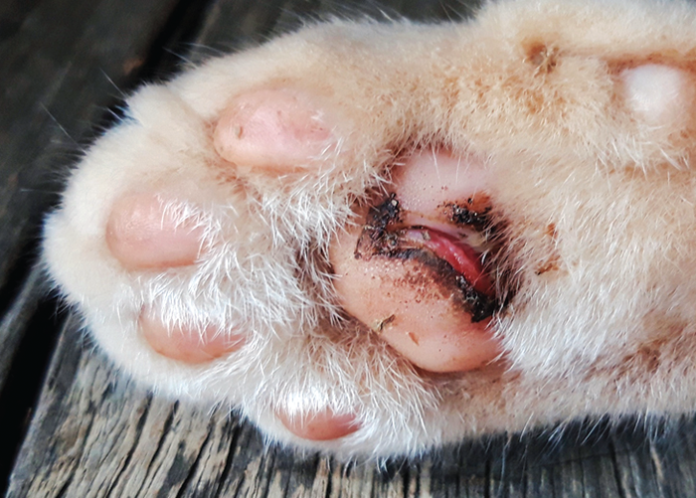You hear glass shatter in the kitchen, an alarmed meow, and your cat comes streaking around the corner, trailing blood.
Cats that go outside are the most likely to sustain injuries due to interactions with other animals or to get cuts from plants, fences, or equipment, but indoor cats can get themselves into trouble, too. Whether your kitty tangled with your favorite ornamental cactus, ran through a home-improvement project, or got caught red-pawed shattering the antique china, a laceration requires prompt attention.
Stop the Bleeding
Once you have identified the location of the wound, apply pressure to stop the bleeding. A non-stick pad is ideal, but any clean cloth or towel will do in a pinch. If possible, position your cat so that the cut is above her heart so that gravity will help you to slow the bleeding as well.
If your cat does not like to be held, you can place a bandage. Place a non-stick pad, sterile gauze, or a clean cloth next to the wound, then wrap it with vet wrap or medical tape. Masking tape can also work if needed—do not use duct tape, as it can cause significant damage to your cat’s skin when removed. Do not use a rubber band, either, as this can obstruct blood flow. The bandage should be snug, but not so tight that you can’t insert at least one finger underneath it.
If your cat bleeds through the cloth or bandage, apply an extra layer. Dislodging the first layer might break up any clots that have formed and cause the bleeding to get worse. Heavy bleeding is an emergency and requires immediate veterinary care, so your goal is to control the bleeding as much as you can while en-route to the veterinary hospital.
Safety First
Always remember that an injured animal can lash out unexpectedly. Even the sweetest cat might bite or scratch when she is hurt and scared. Be cautious when handling your bleeding cat, and wrap her in a towel or use a cat muzzle if available to prevent her from accidentally biting or scratching you.
Fractious cats may require sedation to examine and treat the wound.
Clean the Wound
Small cuts and lacerations may be manageable at home, but it is always a good idea to check in with your veterinarian to be sure that further therapy is not warranted. If you are able to stop the bleeding, gently assess the wound. Even tiny cuts on the ears and face can bleed profusely, making the situation seem much worse than it actually is. Lacerations that have severed an artery or vein will usually bleed more stubbornly than cuts and scrapes that only involve skin.
Pat the wound with a clean cloth and gently flush it with either sterile saline or fresh water. Flushing the wound will help to dislodge any debris or bacteria that may be present. You may be able to gently remove larger objects, such as shards of glass or metal. If you can see glass or other debris but can’t get it out easily, your cat may need to be sedated by your veterinarian to properly clean the wound.
Small cuts that don’t go all the way through the skin will often heal on their own. Once you have cleaned the area, keep your cat confined to an area in your house where you can keep an eye on her for the next few days. If the cut is on her paw pad, confine her to a single room or a large dog crate to limit her activity so she isn’t constantly stepping on the paw and opening the cut back up. Check at least once a day to make sure that the cut is clean and hasn’t opened up. Signs of infection include red skin, skin warm to the touch, swelling, and pus. If your cat starts to show signs of infection she needs to be seen by your veterinarian.
What You Can Do
- Apply pressure until the wound stops bleeding
- Flush the wound with sterile saline or clean water
- Call your veterinarian to determine if your cat requires urgent care or antibiotics
- Always call your veterinarian if you suspect the injury is due to an animal bite
Visit Your Veterinarian
Most cuts can benefit from a veterinary exam to evaluate the severity of the wound and get your cat started on antibiotics (especially important if the laceration occurred outside or has debris in it—these “dirty” wounds can easily get infected). Minor lacerations that only affect the skin can often wait for an appointment during regular business hours.
A laceration is an emergency if:
- You can’t stop the bleeding within 15 minutes
- Your cat is bleeding profusely
- The cut exposes muscle, bone, or nerves
- Your cat shows other signs of illness (lethargy, weakness, difficulty breathing, loss of consciousness, abnormal behavior)
If you are unsure of whether or not your cat requires emergency care, call your veterinary office. Most clinics now have email and/or office cell phones and can give you instructions to take a photo of your cat’s lacerations and send it to them. The staff can then help you schedule an appropriate appointment.
If your cat is bleeding heavily, maintain pressure on the wound while en route to the hospital. Hold your cat while a friend or family member drives, or apply a bandage. Your cat should be restrained to keep her safe during the drive. Wrap her in a towel to prevent her from scratching you if the car hits a bump, or place her in a cat carrier. If you have a fractious cat and don’t have a cat carrier, a pillowcase can work well as emergency kitty transportation.




